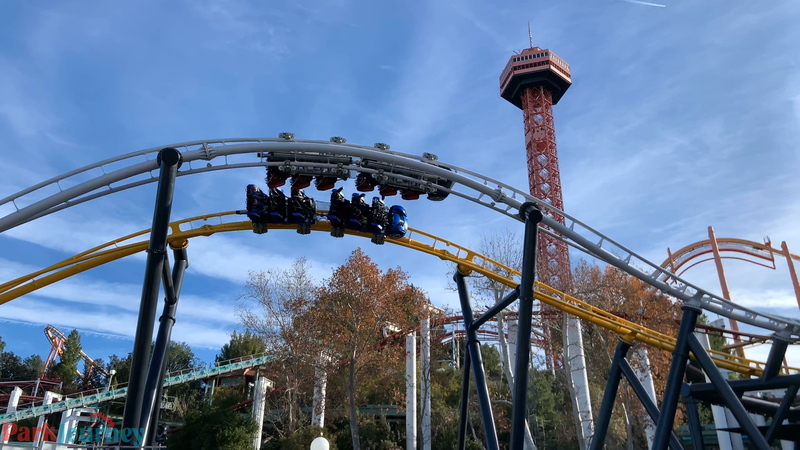|
This morning, a series of events has caused Six Flags to issue a red-flag warning about the near and long term future of the company, and that the financial situation there is finally coming to clearer view in 2020. If you've read some of my analysis of the issues at SFInc. for the past few years, I've issued some warnings based up on their fiscal situation, and the issues carrying forward. Their debt situation, the gambling on foreign growth, and the lack of forward investment in their existing parks has been a background cause-effect push that is now showing the results. In the long-term, the future is not clear, and nearly impossible to completely figure out a due course on. However, there are some things which are clues to the future and to what the next steps for SFInc. are. DEBT: SFInc's debt picture has never been very strong - in fact, under Jim Reid-Andersen's leadership, the company has racked up a rather stunning $3.6 BILLION in direct debt. At the same time, the spending and paying out of dividends for the company have been nearly all of the operational profits in the company for the better part of five straight years. This, combined with an unwise stock buyback program has kept the stock price artificially high. Where other companies (more wisely) will take portions of the profit and re-invest them back in the company's interests, the company chose to give the money back to the investors and shareholders, of which a good chunk of the board of directors at SFInc. The result is the assets owned now are exceeded by the debt of the company, with a nearly $1.0 BILLION negative equity ratio. What that means is that there is more debt to assets at SFInc, and that the situation is not getting better. FOREIGN PARK LICENCING/MANAGEMENT: SFInc. has been busy trying to grow the brand by licencing out their parks overseas. Operations in the Middle East (Dubai/Abu Dhabi) and China (Several parks) would have granted additional cash flow into the company with little investment directly. SFInc. was to have made profits off of operating and licencing the parks, as one estimate under J.R.A. was as high as nearly $400,000,000.00 per year. The bubble burst here. In fact, as of the notice this morning, the Chinese projects have defaulted in payments to not only SFInc. but also to several major ride builders. This alone will cost the company directly (The actual figures are not known at this point - but will be soon.) In addition, the Dubai/Abu Dhabi projects died in progress - leading to an even bigger deficit on the financials of SFInc. LACK OF PARK INVESTMENT: For years now, SFInc. has relied on the duplication process within most of their parks. Standardized rides such as Justice League, SkyScreamers, RMC rebuilds and other projects have taken center stage while the addition of unique experiences to other parks has become the driving force behind Six Flags's expansion strategy. It didn't work. While a handful of the parks got new and creative expansions (West Coast Racers, Wonder Woman at Six Flags Fiesta Texas, MAXX Force at Six Flags Great America), other parks and smaller parks simply got the runaround, and a series of duplicated flat rides with various DC Universe names on it. Some creative new flat rides ended up being duds and were expensive flops; other rides failed to generate the needed buzz and excitement. Even some of the largest (and more profitable) Six Flags parks did not gain much over the years, despite their ability to generate higher profits for the company. And lest we forget Six Flags St. Louis. SFinc. certainly has. It has been many years since any serious investment in the park has happened. The result is that the asset base (the owned parks and the attractions therein) has actually SHRUNK - leading to less property equity on the balance sheet, and further eroding the fiscal state of the company. LACK OF PASSHOLDER/MEMBERSHIP GROWTH: It was revealed today that the company's plan to grow forward and increase the passholder base over the years has in fact failed - with a negative growth rate in 2019. Passholders generate quite a bit of revenue overall, and the gamble was their higher return rate to the parks would generate additional revenues overall. In effect, this was a HUGE mistake. With the rise of the dining plan, and the higher-tier membership plans, once those tickets are paid for, revenue per head drops drastically per visit. If you are a frequent flyer, you will cost the company more money per head than what they expected. This was a fallacy that has been many years in progress. In addition, these value based tickets were priced at bargain basement prices - ones that are unprofitable at almost any price level. If you compare the annual prices for a Cedar Fair Season Pass vs. a Six Flags Season pass, you see the prices for Cedar Fair are FAR higher. Even higher than that is a pass to a Herschend Park - at nearly 4x the price of a Six Flags pass. In effect, they are pricing the passes for profit - not for attendance drives. In turn, they are making more money per park entry than others are. THE FUTURE: Six Flags has been dancing on the financial knife now for many years. The new CEO who took over from Jim Reid-Anderson is now seeing the financial difficulties that the SFInc. is entering - and now has a situation that is going to be painful and long-lasting. Over the next seven years, SFInc. will face financial obstacles including their long and short term debt issues, in addition to several very large payments due from 20 plus years ago. This includes issues with both the Texas and Georgia properties (neither of which are owned outright by SFInc, but rather owned by private lease-hold groups and managed by SFInc.) in addition to land leasing issues with a number of their parks (Six Flags Discovery Kingdom and Six Flags Great Escape). These will be expensive to renegotiate, and potentially could mean further cuts and price increases. The solutions are out there - the question remains how to make the best out of a very rough situation. SFInc. has some good strengths - but must capitalize on them to make right course changes in their company path. First, they must SHRINK. By this, it is time to let go of the Texas and Georgia properties, and sell them for what they are worth to new owners. These two parks will need nearly $500,000,000.00 in system and physical upgrades over the next 10 years - namely as these two parks are well into their 50's. Infrastructure upgrades are necessary to maintain these aging parks in addition to new attractions and restoration/revitalization of older ones. Second, they must INVEST. SFInc. needs to realign their spending and instead of pumping out massive dividends to keep their stock price afloat, they need to put money into all the parks in their system - both owned and leased. The Xerox machine needs to be thrown out, and creative minds without the expensive licencing agreements need to become standard again. Not every park needs Magic Mountain rides, but ALL parks need new attractions to stay fresh and creative - and to draw more people into their gates more often. Duplication failed - it's time for a new approach. At the same time, they must increase ticket prices - in some cases doubling the prices on some season pass/membership levels to reflect the appropriate level of visits and services expected. Third, they must FOCUS. Instead of trying to be the biggest name everywhere through management-leasing parks in addition to the owned chain parks, they need to FOCUS on making what they have work, instead of building a network of so-so (or worse...) parks. People will not visit other parks in the system regularly if they have no need to because their existing park is crap. Fourth, they need to learn TREATMENT. One of the biggest complaints I know from talking to people working at SFInc. is the treatment of the employees - and in return, the treatment of the guests. Customer Service in the parks is consistently inconsistent, and can vary from exceptional down to absolutely awful (Sadly, for some parks, the latter is more common than the former.) A return to friendlier policies and more guest-centered ideas should be a primary focus. Instead of looking at the guests as a nuisance, look at each one as a friend, a family member, a loved one. A better attitude and a better experience = more guests returning and spending money there. Over the next 90 days, Six Flags Inc. will be coursing a very narrow and dangerous path. Financially speaking, the bad deeds and bad habits of JRA's past are now coming visible, and SFInc. is now in a dire situation. It will take creative leadership and creative re-design of the company to emerge again ready to compete. Or there will be one hell of a fire-sale on used rides shortly. R.D. Dewberry 1/10/2020 Related Videos:
Related Updates:
2 Comments
Jim
2/17/2020 01:20:54 am
What happens either when a recession hits and attendance goes down, or interest rates go up and the debt becomes more expensive to carry?
Reply
Right now, SFInc's debt is already at some astoundingly high interest rates, and their current credit rating is quite bad. This alone is handicapping them in a roaring economy, let alone if a travel industry recession hits.
Reply
Leave a Reply. |
Archives
August 2022
|













 RSS Feed
RSS Feed